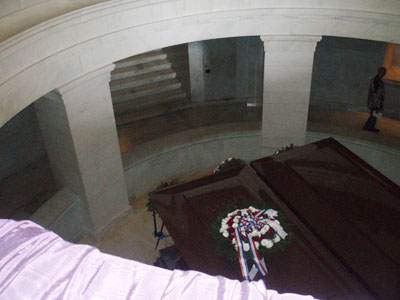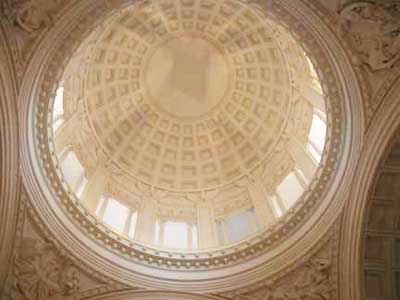
Memorial honors contribution of president
NEW YORK — Who is buried in Grant’s Tomb? From 1947 to 1961, American television star Groucho Marx asked people this question on the game show You Bet Your Life. This helped ensure that contestants who did not win anything would at least go home with a consolation prize.
While most contestants would reply “Grant” and Marx would give them a prize, anyone who has actually been to Grant’s Tomb knows that the answer is no one: both Ulysses S. Grant and his wife Julie are entombed, not buried within the ground.
| At right, Grant’s Tomb, dedicated on April 27, 1897. This would have been Grant’s 75th birthday (Photo by Bolton Lancaster). Below, the sarcophagi of Grant and his wife Julia lie in the mausoleum (Photo courtesy of the General Grant National Memorial). |
The main attraction of the Gen. Grant National Memorial, located in the Morningside Heights neighborhood of Manhattan, is the giant mausoleum in which Ulysses and Julie Grant are entombed.
John Duncan designed the final resting place of the former general and president in a neoclassical style, with 10 big stone pillars at the top of the stairs that lead inside as well as an enormous rotunda that tops off the structure.
The mausoleum stands out in New York as a building heavily influenced by ancient Greek architecture surrounded by mostly residential areas. In fact, many visitors say that it reminds them of monuments in Washington, D.C. because of its sheer size and design.
 “All our famous people are in Washington so we should be looking at it as a gift that New York has somebody famous,” said Vera Stanley, who has lived in New York her entire adult life but was visiting the memorial for the first time.
“All our famous people are in Washington so we should be looking at it as a gift that New York has somebody famous,” said Vera Stanley, who has lived in New York her entire adult life but was visiting the memorial for the first time.
The interior of the mausoleum is simple in design but grand in structure, as it is 151 feet from the base to the top of the rotunda. White marble was used to construct the floor as well as the railings.
“I love the reaction of people, from the little kids to the adults. They’re blown away with how big it is and how majestic it is,” said Glenn Hawley, a ranger who has been working at the memorial since summer.
In the middle, sitting about 15 feet below the main level, sits the sarcophagi of Ulysses and Julie Grant. Visitors can visit this crypt area by descending down the stairs at the far end of the mausoleum.
Once down on the lower level, visitors can see the monumental busts of some of Grant’s senior generals: Philip Sheridan, James McPherson, William Sherman, Edward Ord, and Henry Thomas.
In addition to the sarcophagi, the mausoleum also hosts two reliquary rooms that contain old flags as well as maps of major battles during the Civil War. The room on the left has maps of major battles in the North while the room on the right contains maps of the major battles in the South.
At the top of each wall is an illustration depicting Grant. These four illustrations give visitors insight into the former general’s life.
“These represent his birth, his time as president, his time at war, and then his death,” Hawley said. “So each one represents a different stage of his life.”
On the sides and back of the mausoleum are paved memorial grounds that contain cement benches covered in colorful artwork where visitors can go to reflect on the life of Ulysses S. Grant. Some people leave flowers, candles and American flags in this area.
| At left, the burial grounds that surround the mausoleum offer art-covered benches for visitors to sit (Photo by Bolton Lancaster). Next, the mausoleum is 150 feet from the bottom of crypt to the top of the rotunda. (Photo courtesy of the General Grant National Memorial). |
The Visitor Center is located across the street from the mausoleum. It was renovated in April 2011 and now houses an exhibition room that covers some of the major events in Grant’s life, a gift shop, a short film about the construction of the mausoleum and restrooms.
A rich history surrounds the man entombed in this grand burial ground. After serving in the Mexican-American War from 1846-48, Ulysses S. Grant first started gaining national attention when he was given control of the Union Army during the Civil War in 1864. Confederate Gen. Robert E. Lee’s surrender of the Northern Virginia Army on April 9, 1865 at Appomattox symbolically marked the end of the bloodiest war in America. Grant continued to serve as general-in-chief of the Union Army until 1869.
Grant ran as a Republican candidate in the presidential election of 1868, ultimately defeating Horatio Seymour, the former Democratic New York governor, by 214 to 80 electoral votes. He went on to be re-elected in the 1872 presidential election, serving as president from 1869-77.
It is only fitting that Grant’s Tomb is part of the National Park Service, as he established the first National Park (Yellowstone) as president in 1872. He also oversaw Reconstruction, the process of integrating the South back into the country. This allowed him continue the job he started when he helped the Union win the Civil War and eliminated the Confederacy.
 Although he served as president, Grant’s Tomb is formally known as “General Grant National Memorial” because he is better known for his career in the military. Perhaps his most important contribution to the country was helping bring a divided country together during and after the Civil War.
Although he served as president, Grant’s Tomb is formally known as “General Grant National Memorial” because he is better known for his career in the military. Perhaps his most important contribution to the country was helping bring a divided country together during and after the Civil War.
“He wasn’t a sore winner,” Hawley said. “When he went over the surrender with Lee, it was actually very positive terms for a losing side. He made sure that they were treated with respect because they were all soldiers. They were fighting for a cause that he did not agree with but he recognized their mental makeup as soldiers.”
The inscription “Let Us Have Peace” is above the entrance into the mausoleum, which is a quote that helps summarize Grant’s legacy both as a general and as president.
Although Grant’s sarcophagus is based on Napoleon’s, Hawley says that there are apparent differences in their military careers and personalities.
“They couldn’t have been two more different people,” Hawley said. “Napoleon was a conqueror whereas Grant was kind of like, ‘We have to do this. We have to fight, but it’s for a good cause, not just for ourselves.’”
Grant spent the final five years of his life in New York City. After passing away from throat cancer in 1885, the location of his memorial was hotly contested as many people wanted it to be in Washington, D.C. However, his wife Julia believed that he would have wanted to be buried in New York. Julia Grant and the Grant Monument Association, a group of New Yorkers helping finance the memorial, ultimately ended up succeeding in their efforts to have the monument in New York.
The Grant Memorial was financed by 90,000 people who donated $600,000. At the time, it was the largest public fundraising effort in history. Construction began in 1891 and was finished in 1897, nearly 13 years after his death. More than one million people attended the parade and dedication ceremony of Grant’s Tomb upon completion. Approximately 500,000 to 600,000 people per month visited the memorial when it first opened.
Unfortunately, attendance has declined over the years. This is largely due to the fact that it is located in a corner of the city that is often less visited by tourists as well as residents.
“This location was chosen because it is someone’s final resting place,” Hawley said. “The remoteness is important for the respect.”
Anthony Diflorio, a student at Seton Hall University, was visiting the memorial for his second time.
“He was a great guy and this is a big place for him but, at the same time, it’s kind of tucked away and hidden,” Diflorio said.
| The small covered area on the banks of the Hudson River sits above the Visitor Center. The restrooms are located in the Visitor Center because, as rumor has it, Julia Grant said that she did not want restrooms in the same place where she was buried (Photo by Bolton Lancaster). |
Stanley, who decided to visit the site after spotting it on a walk, agrees.
“It’s off the beaten tourist path,” Stanley said. “It doesn’t fit with people’s impression of New York.”
However, the lack of crowds helps add to the solemn, respectful ambiance of Grant’s Tomb. Stanley believes that it is “peaceful” and gives people “the ability to reflect.”
“The respectful nature of this site is different from some of the others,” Hawley said in reference to other national monuments. “At Mount Vernon, the farm and the house are very important but they’ve made it into a mall. It’s got a crazy food court and gift shop and all this other stuff.”
Despite the fact that it might not be as popular as some of the monuments in the D.C. area, Diflorio still recommends people to go visit.
“If you know anything about Grant, go in and check it out,” Diflorio said. “Even if you don’t, it’s still an interesting experience.”
If You Go
- General Grant National Memorial is located in Riverside Park in Manhattan. The entrance to the mausoleum is located near the intersection of Riverside Drive and West 122nd Street.
- The mausoleum is open Thursdays through Mondays from 10 a.m. to 11 a.m., 12 p.m. to 1 p.m., 2 p.m. to 3 p.m., and 4 p.m. to 5 p.m.
- The Visitor Center is open Thursdays through Mondays from 9 a.m. to 5 p.m.
- Free talks are available at the Visitor Center Thursdays through Mondays at 11:15 a.m., 1:15 p.m., and 3:15 p.m.
- General Grant National Memorial is closed on Tuesdays and Wednesdays.
- The site is closed on Thanksgiving Day and Christmas Day every year.
- The memorial site is free to visit.
- The restrooms are located at the visitor’s center located on the other side of Riverside Drive.
- The General Grant National Memorial can be contacted at 212-666-1640.
- More information can be found online at http://www.nps.gov/gegr/index.htm.

Comments are Closed